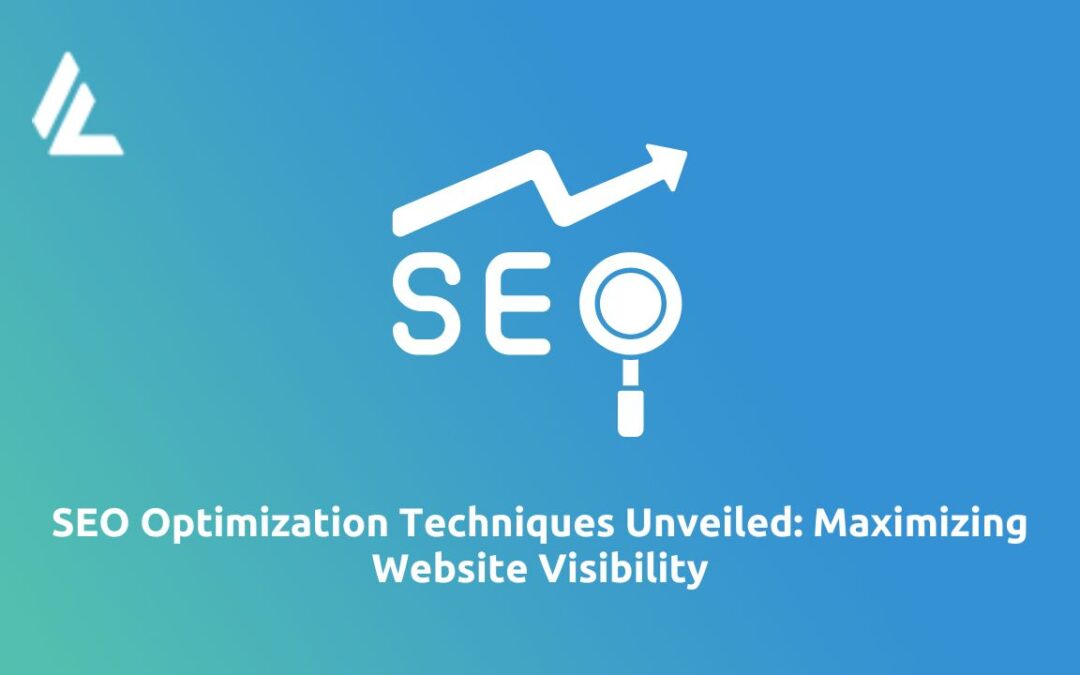Table of Contents
Having a website is like owning a ship crossing unexplored waters in the enormous ocean of the internet. But just like a ship needs navigation to get where it’s going, a website needs optimization to make its way through the vast digital world. Search Engine Optimization (SEO) functions as a compass that directs websites toward increased visibility and better search engine rankings. It’s the essential tool that makes sure websites sail smoothly toward their intended destination of improved visibility and organic traffic rather than becoming lost in the sea of competition.
We’ll go over several SEO optimization Techniques that are crucial for raising a website’s exposure and generating organic traffic in this extensive tutorial. Every tactic helps make the digital world easier to navigate, from carrying out in-depth keyword research to creating engaging content, optimizing on-page components, fixing technological problems, guaranteeing mobile friendliness, and constructing high-quality backlinks. Through the proper use of these strategies, websites can carve out a distinct path through the enormous digital void, leading to success and recognition within the dynamic online community.
Websites may confidently traverse the intricacies of the digital realm by using SEO as their compass. Websites may effectively engage and captivate their target audience in addition to increasing their visibility by utilizing optimization tactics. Websites that use SEO as their compass set out on a voyage towards increased visibility, natural traffic, and long-term expansion in the ever-changing online landscape.
Understanding SEO Optimization Techniques
SEO optimization techniques are a multifaceted approach aimed at bolstering a website’s search engine ranking and visibility. From careful on-page optimization to calculated off-page actions, every tactic makes a big difference in improving a website’s online visibility. Adding pertinent keywords to specific web pages, streamlining meta tags, headers, and titles, and guaranteeing quick page loads are all part of on-page optimization. By paying close attention to detail, the website’s relevancy is enhanced and search engines are alerted to its authority, which eventually results in higher visibility and organic traffic.
Off-page SEO tactics emphasize establishing a website’s authority and reputation through outside sources, which is a complement to on-page SEO work. This entails building solid internet connections within the sector, obtaining high-quality backlinks from reliable websites, and utilizing social media channels to amplify information. Off-page strategies improve a website’s overall visibility and rankings by building a strong presence outside of the website’s content. This helps search engines see the website as relevant and trustworthy.
SEO optimization techniques encompass a myriad of strategies aimed at improving a website’s search engine ranking and visibility. From on-page optimization to off-page strategies, each technique plays a crucial role in enhancing your website’s online presence. Let’s delve into some key SEO optimization techniques:
1. Keyword Research and Optimization
Keywords are the foundation of SEO. These are the terms and expressions people type into search engines to locate pertinent data. Discovering high-volume, low-competition keywords that are pertinent to your niche is essential to effective keyword research. After you’ve chosen your target keywords, carefully incorporate them into the body text, headers, titles, and meta descriptions of your website.
2. High-Quality Content Creation
When it comes to search engine optimization, content is king. Users who find valuable, informative, and engaging content on websites that rank higher in search results. Write content that speaks to your target audience’s needs and interests while organically including relevant keywords. Update your website often with new, interesting content to keep users interested and entice them to return.
3. On-Page Optimization
Optimizing individual web pages to raise their search engine ranks is known as on-page SEO. This entails adding pertinent keywords to headers, URLs, title tags, and meta descriptions. To improve user experience and SEO performance, make sure your website has a clear structure, simple navigation, and pages that load quickly.
4. Technical SEO
To increase your website’s search engine visibility, technical SEO focuses on optimizing its technical elements. This involves building an XML sitemap, applying schema markup, repairing broken links, and speeding up the website. You can guarantee that search engines can efficiently crawl and index your website by taking care of technical concerns, which will improve your website’s ranks.
5. Mobile Optimization
Since mobile devices are used by the majority of internet users to visit websites, mobile website optimization is crucial for SEO performance. Make sure the design of your website is mobile-responsive, meaning it will adjust to various screen sizes and devices without any problems. Websites that are optimized for mobile devices are likely to appear higher in mobile search results, increasing their visibility overall.
6. Link Building
Building links is still a key component of SEO improvement. Getting reputable websites to link to your website with high-quality backlinks tells search engines that your website is reliable and legitimate. Prioritize establishing connections with pertinent websites in your field and obtaining organic backlinks by producing quality content and conducting outreach.
Do Check out our related blog on Search Engine Optimization

Implementing SEO Optimization Techniques
Now that we’ve explored various SEO optimization techniques, let’s discuss how to implement them effectively:
1. Start with Keyword Research:
To locate pertinent keywords with a large search volume and little competition, use tools like Ahrefs, SEMrush, or Google Keyword Planner.
2. Create Compelling Content:
Create relevant, high-quality material that appeals to your target audience and organically includes your goal keywords.
3. Optimize On-Page Elements:
Optimize title tags, meta descriptions, headers, and URLs with relevant keywords to improve search engine visibility.
4. Address Technical Issues:
Perform routine technical audits to find and fix problems with broken links, schema markup, and site speed that are impacting the functionality of your website.
5. Optimize for Mobile:
Make sure your website works well on mobile devices and offers a consistent user experience.
6. Build Quality Backlinks:
Prioritize establishing connections with reputable websites to obtain organic backlinks through outreach and content production.
Conclusion
SEO optimization techniques are essential for enhancing your website’s visibility and driving organic traffic. You may raise your website’s search engine ranks and get more traffic by putting tactics like keyword research, content production, on-page optimization, technical SEO, mobile optimization, and link building into practice. As the digital landscape changes constantly, don’t forget to continually assess and modify your SEO efforts to stay ahead of the curve. You may easily travel the wide ocean of the internet with a well-optimized website, arriving at your intended destination of greater success and visibility.
So, start your SEO adventure now and use efficient optimization strategies to unleash the full potential of your website.

